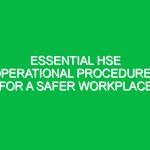Introduction
In the realm of Health, Safety, and Environment (HSE) compliance, navigating the complex landscape of Regulations and inspections can be daunting. One crucial aspect of this process is the Occupational Safety and Health Administration (OSHA) inspection search, which plays a pivotal role in ensuring Workplace Safety and regulatory adherence. Understanding the intricacies of osha inspections can empower organizations to maintain compliance, enhance employee Safety, and ultimately foster a culture of health and well-being.
This article delves deep into the significance of OSHA inspection searches in the HSE context, uncovering essential tips and strategies that organizations can implement to ensure they are prepared for inspections, understand their rights and responsibilities, and ultimately create safer work environments.
Understanding OSHA Inspection Searches
Before we dive into the details, it’s essential to clarify what an OSHA inspection search entails. An OSHA inspection is an examination conducted by OSHA officials to ensure that employers comply with the Occupational Safety and Health Act, which aims to guarantee safe and healthful working conditions. These inspections can be triggered by various factors, including employee complaints, referrals, or even random inspections.
An OSHA inspection search typically involves reviewing safety protocols, examining equipment, and interviewing employees to assess the overall safety culture of an organization. Compliance with OSHA Standards is not just about avoiding fines; it’s about fostering a work environment that prioritizes health and safety.
The Importance of OSHA Inspections in HSE
The relevance of OSHA inspection searches in the HSE domain cannot be overstated. Here are several reasons why these inspections are vital:
- Enhanced Safety: Regular inspections help identify potential Hazards before they escalate into serious incidents.
- Legal Compliance: Adhering to OSHA standards reduces the risk of legal repercussions and fines.
- Employee Morale: A commitment to safety fosters trust and enhances employee morale.
- Operational Efficiency: Safe work environments often lead to increased productivity, as employees are less likely to take sick leave due to workplace injuries.
Key Components of an OSHA Inspection Search
Understanding the key components of an OSHA inspection search is essential for any organization striving to maintain compliance. Here are the primary elements involved:
1. Types of Inspections
OSHA conducts several types of inspections, including:
- Routine Inspections: Scheduled inspections that occur at specific intervals.
- Random Inspections: Unannounced visits to ensure compliance.
- Complaints-Based Inspections: Triggered by employee complaints regarding unsafe conditions.
- Accident Investigations: Conducted after serious accidents to determine the cause and prevent future occurrences.
2. The Inspection Process
The inspection process generally follows these steps:
- Opening Conference: The inspector introduces themselves and explains the purpose and scope of the inspection.
- Walkaround: The inspector conducts a physical examination of the workplace, looking for Hazards and compliance issues.
- Employee Interviews: The inspector may interview employees to gauge their understanding of safety protocols.
- Closing Conference: The inspector discusses findings with management, outlining any violations and potential penalties.
3. Documentation and Recordkeeping
Documentation is a crucial aspect of the inspection process. Employers should maintain records of safety Training, incident reports, and any previous OSHA inspections. This documentation not only helps during an inspection but also demonstrates a commitment to maintaining a safe workplace.
Best Practices for Preparing for an OSHA Inspection
Preparation is key when it comes to OSHA inspections. Here are some Best Practices organizations can implement:
1. Conduct Internal Audits
Regular internal audits can help organizations identify and rectify potential safety issues before an OSHA inspector arrives. This proactive approach not only fosters compliance but also cultivates a safety-first culture among employees.
2. Train Employees on Safety Standards
Employee training is fundamental to maintaining compliance. Ensure that all employees are aware of OSHA standards relevant to their roles and understand the importance of adhering to these protocols.
3. Develop a Safety Action Plan
A comprehensive safety action plan should outline Procedures for reporting hazards, conducting inspections, and responding to emergencies. This plan should be readily accessible to all employees.
4. Designate a Safety Officer
Having a dedicated safety officer can streamline the compliance process. This individual should be responsible for ensuring that safety protocols are followed and that employees are trained appropriately.
Common OSHA Violations and How to Avoid Them
Understanding common OSHA violations can help organizations avoid pitfalls during inspections. Here are some prevalent issues:
- Fall Protection: One of the most cited violations, organizations must provide proper Fall Protection measures for employees working at heights.
- Hazard Communication: Employers must ensure proper labeling of hazardous materials and provide safety data sheets.
- Respiratory Protection: In environments where air quality is compromised, employers must provide appropriate respiratory protection.
- Lockout/Tagout: Proper procedures must be in place to ensure that machinery is properly shut off during Maintenance.
To avoid these violations, organizations should conduct regular training sessions, ensure that safety equipment is up to standard, and foster open communication regarding safety concerns.
Regulations and Standards Governing OSHA Inspections
Understanding the regulations and standards that govern OSHA inspections is essential for compliance. The following are key regulations:
1. Occupational Safety and Health Act (OSHA Act)
The OSHA Act lays the foundation for Workplace Safety regulations. Employers are required to provide a workplace free from recognized hazards.
2. General Duty Clause
This clause mandates that employers must keep their workplace safe and healthy, even if specific standards do not exist for certain hazards.
3. Industry-Specific Standards
Various industries have specific OSHA standards that must be followed. Employers should familiarize themselves with the regulations applicable to their industry to ensure compliance.
Real-Life Case Study: A Company’s Journey to Compliance
Consider the case of a manufacturing firm that faced multiple OSHA violations due to inadequate safety protocols. After receiving significant fines and facing potential shutdowns, the management decided to overhaul their safety practices. They initiated a comprehensive safety training program, conducted regular internal audits, and designated a safety officer.
Within a year, the company not only rectified the violations but also saw a 30% reduction in workplace accidents. This transformation not only saved them from further fines but also boosted employee morale and productivity.
Conclusion
In conclusion, understanding the intricacies of OSHA inspection searches is crucial for organizations committed to HSE compliance. By embracing Best Practices, conducting regular training, and fostering a safety-first culture, companies can navigate the complexities of OSHA regulations effectively. The importance of these inspections extends beyond compliance; they are integral to promoting a safe and healthy work environment for all employees.
Organizations should view OSHA inspections not merely as regulatory hurdles but as opportunities for improvement and growth. As the landscape of Workplace Safety continues to evolve, staying informed and proactive will ultimately lead to a more resilient, compliant, and safety-conscious organization.


